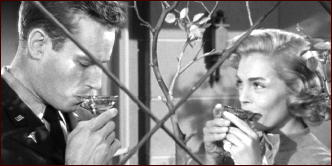Mon 11 Aug 2014
A Western Movie Review by Jonathan Lewis: THE LAW AND JAKE WADE (1958).
Posted by Steve under Reviews , Western movies[6] Comments
THE LAW AND JAKE WADE. MGM, 1958. Robert Taylor, Richard Widmark, Patricia Owens, Robert Middleton, Henry Silva, De Forest Kelley. Based on a novel by Marvin H. Albert (Gold Medal, 1956). Director: John Sturges.
The Law and Jake Wade has many of the requisite elements of an above average 1950s Western. Directed by John Sturges, whose Last Train From Gun Hill I reviewed here, the film boasts an impressive cast and an even more impressive natural scenery of the Alabama Hills and the High Sierras. There are some incredibly well shot action sequences to boot.
Overall, the film has a quite stark and gritty feel to it. This dovetails nicely with the film’s plot about a man seeking a domestic, morally upright life far removed from both his wartime experiences and his criminal past.
Yet, despite all this, the film nevertheless ends up feeling as something of a letdown. It’s not so much that the plot doesn’t work, as it is that outlaw-turned-lawman Jake Wade, as portrayed by a taciturn Robert Taylor, just isn’t all that a compelling Western protagonist.
Instead, the film’s evilly grinning villain, played by Robert Widmark, ends up being the movie’s center of gravity. Without him as an antagonist, the viewer might find it very difficult to care about Jake Wade.
The film begins with Jake Wade (Taylor) breaking Clint Hollister (Widmark) out of jail. He does it out of a perhaps misplaced sense of loyalty to the man, because as it turns out, the two men used to be partners in crime. That is, until Wade accidentally shot and killed a young boy in a bank holdup (or so he believes). Wade’s left the criminal life behind him and has set up shop in a new town with a lovely girl and a job enforcing the law as opposed to breaking it.
But Hollister and his men aren’t about to let Wade walk out of their lives so readily. There’s the pesky matter of stolen cash that Wade, now a Marshal, allegedly buried, and Hollister wants his share of the loot.
So he kidnaps Wade and his fiancée, Peggy Carter (Patricia Owens), with the goal of forcing them to take him to where the money is buried. Assisting him in his endeavor is his gang, including the lanky sociopath Rennie (Henry Silva) and the violent but loyal Wexler (Star Trek’s DeForest Kelley in a great role). It’s Widmark’s character that makes the movie increasingly suspenseful.
The rest of the movie follows this ragtag expedition as they traverse mountain paths, hole up in a ghost town, and do battle with Comanches.
And, naturally, there’s a final shootout between Jake Wade and Clint Hollister. Wade ends up killing his former partner, allowing him to at least have an opportunity to put his dark past behind him once and for all.
It’s only too bad that the character of Jake Wade was never developed beyond what is essentially a stereotypical Western anti-hero, a former Confederate soldier and outlaw who wants a fresh start.



